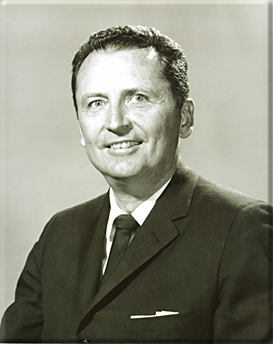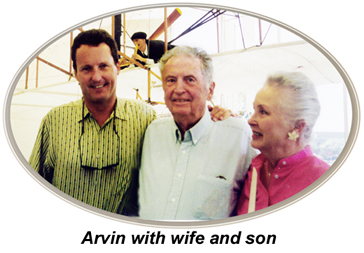


|

|
Arvin Basnight was born and raised within site of Kill Devil Hill. He has known most of those actively involved with the first flight. He served 40 years as a Ranger, B-17 pilot in the famous 91st Group, and had key roles in the CAA/FAA. He enjoys the people who appreciate the challenges of aviation.

The thrill of flying and understanding what makes it possible started early in my life. I was born and raised on Roanoke Island in North Carolina. From my family's boat landing, there is a great view of Kill Devil Hill and Kitty Hawk. Of the seven people involved with the first flight by the Wrights, I have known five of them. This includes Coastguardsman Will Dough; Adam Etheridge who also had custody of their equipment when they were away, John T Daniels who made the photograph of the first flight; Johnny Moore a special boy and Orville Wright who shared a day with me.
Other local persons I have known, who were not present for the flight, but were involved with the Wrights. Bill Tate a prime factor in bringing the Wrights to Kitty Hawk and accommodating them in many ways and Alf Drinkwater a weatherman and telegrapher.
In my childhood our lifestyle was not centered around television. We sat with and learned from our elders. The local lore centered around the Wrights, Virginia Dare, Blackbeard, Fessenden, Lindberg's visit and Billy Mitchell. I was stimulated by these stories and characters and they helped shape my career.
I studied Engineering for two years at N. C. State then got a job in Washington and attended night school studying public administration. In 1938 while serving as the first uniformed guide at the Wright Memorial Orville Wright to my surprise pulled up in his big black Hudson sedan. Following a lengthy discussion about the Monument, the visiting public and their interests, he asked me a favor, that I drive him around to several sites. In particular, the spot on Roanoke Island where Reginald A. Fessenden had experimented with wireless telegraphy.
As we rode around, Mr. Wright expressed a lot of feeling about the frustrations they experienced as they sought a patent and recognition of what they bad achieved. It seemed to hurt him that in 1903 only five newspapers in the U. S. had published accounts of their flight. Furthermore approval of their patent application had been delayed until President Wilson interceded in 1915.
He related there was a lot in common in their experience and that of Fessenden. In perspective, he seemed to have, hungered for acceptance and recognition when Wilbur was alive.
We drove through the town of Manteo. He was not interested in talking with people but anxious to have lunch at a good place. We stopped at Bill Parkinson's who insisted on showing Mr. Wright his own invention which was a wooden barrel bored with holes and strawberries planted in the holes. As we were eating, Mr. Wright's comment was "Arvin you see what I have to put up with." After touring Roanoke Island and Kitty Hawk, Mr. Wright left for Elizabeth City on his way back to Dayton.
In 1940 the CAA was expanding, and I was employed primarily to recruit Air Traffic Controllers. The work involved pioneers in our airway system and Jack Morris whose ideas led to the Civilian Pilot Training Program.
On December 6, 1941 Marjorie Gauthier accepted my band in matrimony. We began a honeymoon tap to the Great Smokies, however the next day Pearl Harbor was bombed and we returned immediately to Washington where I joined the Army Air Corp. Our marriage has been happy and we have three children. Mary Ann is married to an aerospace engineer, Bill is a Boeing 757 Captain and Mike is an invasive cardiologist.
After cadet training, I became a B-17 pilot and was assigned to the 91st Bomb Group in the 8th Air Force. This groups performance earned many citations, awards and honors. The movie Memphis Belle dramatized some of the early events but there were 340 missions and the loss of 420 B-17's in the groups record. Our crew reported in just before "D" day and most of our crew finished 35 missions. Our plane was named "Cherie" And sported a picture of Marjorie as nose art.
Among those missions there are two that are linked to NASA. Allied defense against the V2 rockets was not effective and the bombing of launching sites was complicated, so the production center at Peenemundee became the target. The plant had been designed and built to survive such action, and we had to go there twice, the last with special bombs. This took care of the plant. The personnel responsible for that program included Werner Von Braun and several associates survived our attacks, and in a few months were working in America in our defense program and later in NASA.
In 1945 I returned to the FAA worked as Budget Officer and other assignments. When Najeeb Halaby became Administrator I was designated to start a new Regional Office in Atlanta to serve seven states and our programs in Latin America. I was returned to Washington DC in 1965 as Associate Administrator with duties including work with the Military on the planned SST. When then Secretary of Defense cancelled Defense support, a lesser plane was undertaken by the British and French. In 1967 I replaced the Director of the Western Region which then included the State of Colorado and those states west of Colorado. I was involved in the safety certification of a number of aircraft including the Lockheed C-141 and L-1011, The Doughs DC-10, and the Boeing 737 and 747.
My work included work with Chief Executive officers of airlines, aircraft manufacturing firms, directors of airports, city managers and congressional committee members.
In these and other experiences, my appreciation of the Wright brothers has continued to grow. Their understanding of elements of nature, science, engineering, quality, training and team work that when properly used makes aviation possible. They also led the way in standards and certification of airmen on an international basis.